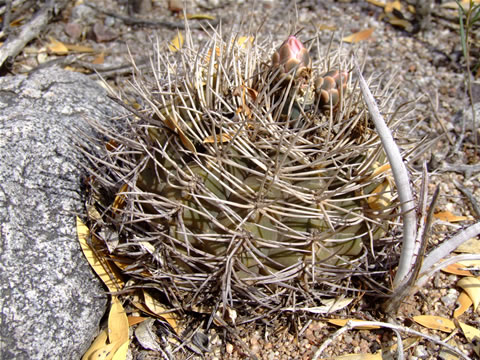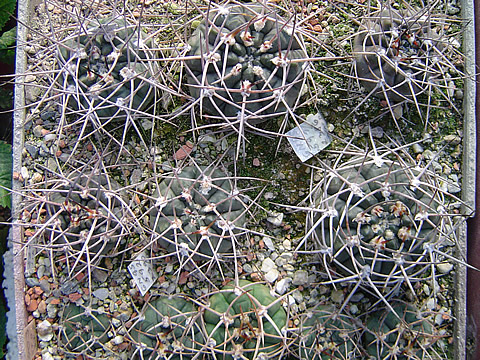Kaktus ABC 269, 417, 1935
Ploše kulovitá plochá těla, až 14 cm široká, 9 cm vysoká, tupě šedozelená. Žebra až 19, nakonec až 2 cm široká, zpočátku jen 8 mm,s vysokými hrbolci, kolem areol silně rozřířená, mezi nimi s širokými trojbokými bradovitými nabo bradavčitými výčnělky. Areoly asi 2 cm od sebe vzdálené, 1 cm dlouhé, nikoliv silně plstnaté.
Okrajové trny většinou 8, po 4 vpravo i vleno do stran směřující, na konci lehce odstávající a propletené, až 3 cm dlouhé; 1 střední trn stejně dlouhý, vzhůru směřující.
Květy zvonkovitě trychtýřovité, nahnědle bíle růžové, s krátkou trubkou, jícen tmavší.
Domovina: Severní Argentina, na jižní hranici s Catamarca u Mazanu.
Gymn. weissianum var. atroroseum Backbg.
Die Cactaceae III, 1763, 1959
Má se od typu lišit delšími, více ohnutými a nepravidelně propletenými trny, a (světle) až sytě růžovými květy.
Gymn. weissianum var. cinerascens – viz Gymn. rhodantherum var. cinerascens
Tak jako Gymn. mazanense, i tyto rostliny přivezl Backeberg ze své jihoamerické cesty roku 1931 a všeobecně se má zato, že rostliny koupil až při zpáteční cestě v Buenos Aires u obchodníka s kaktusy Stümera. Backeberg v následujících letech importy nenabízel, nabízel pak pouze semena. O rozšíření Gymn. weissianum se zasloužil brněnský gymnofil ing. Bohumil Ryšánek, který semena objednaná u Backeberga vysel. Poté tento pěstitel utrpěl úraz na trafostanici kde pracoval, a jeho sbírku převzal Zdeněk Fleischer, který Gymn. weissianum dále rozšířil.
Po mnoha letech navštívili naleziště tohoto taxonu Alfredo Lau a Brigitte a Jörg Piltzovi a všichni se domnívali, že Gymn. weissianum a Gymn. mazanense pocházejí z jedné velmi variabilní populace s mnoha přechodovými formami a je takřka nadlidský úkol přisoudit takovým jedincům správné jméno. Gymn. weissianum se mělo od Gymn. mazanense lišit hlavně barvou epidermis, barvou trnů a také tím, že má vždy jeden střední trn. Barva těla v protikladu ke světlému Gymn. mazanense by bývala měla být velmi tmavě šedozelená a trny světle šedé.
Hans Till a Helmut Amerhauser se pokusili taxon zpracovat v rakouském Gymnocalycium 17 (4), 2004, popisují historii taxonu a závěrem určili, že taxon má stanoviště v Sierra de Velasco, tvoří někdy i vícehlavé skupiny, článek je doprovázen pěknými barevnými snímky, které jen potvrzují, že jako Gymn. weissianum jsou zde určeny vlastně Piltzovy rostliny Gymn. mazanense var. polycephalum P 223. Přesně tak to dopadne, když autor jména váhá více jak dvacet let s popisem.
Podle Tilla a Amerhausera se má tedy Gymn. weissianum lišit od vzhledově podobného Gymn. guanchinense velmi hustým, nejčastěji přímým, vzácně pokrouceným otrněním, u starších rostlin s jedním, vzácně dvěma, k vrcholu směřujícími středními trny a štíhlejšími květy.
Před zveřejněním tohoto dílka jsme za Gymn. weissianum považovali populace odpovídající habitem právě od Chilecito, např Gymn. weissianum aff. guanchinense P 79 Chilecito, které autorská dvojice Till –Amerhauser zařadila k do té doby pochybnému taxonu Gymn. rhodantherum. Je možná chybou, že Backeberg nebyl důsledný, také v té době nebyly informace z nalezišť tak běžné a dostupné, a nenechal v platnosti jeho Gymn. mazanense var. roseiflorum s následným synonymem Gymn. rhodantherum. Dnešní Gymn. rhodantherum a Gymn. weissianum jsou uměle vykonstruované taxony, které se možná daleko liší od představ svých původních autorů popisů. A nemýli-li bychom se příliš při tvrzení, že Gymn. rhodantherum a Gymn. weissianum byly totožné taxony.
K problematickému vztahu Gymn. weissianum – Gymn. mazanense var. polycephalum napsal velmi zdařilý příspěvek redaktor Gymnofila p. Radek Řepka (2007/2). Oba taxony považuje za nadále oddělené a práci rakouských gymnofilů asi nepovažuje za zdařilou. Článek p. Řepky lze jen přivítat a velmi mile mne překvapil – že by se nové vedení spolku konečně probralo z více jak 10 let trvajícího zimního spánku? Problematika druhů weissianum – mazanense – rhodantherum – hossei je stále otevřená. Jen mne jímá hrůza a děs, pokud by měla tuto problematiku zpracovat stejná autorská dvojice, jak tomu bylo u Gymn. weissianum.

Gymn. weissianum near Tama, foto Ch

Gymn. weissianum GN 95-592.2390 Chilecito
Gymn. weissianum – summary:
Gymn. weissianum var. atroroseum Backbg. – It ought to differ from the type with longer, more curved and irregularly twisted spines, and (light) to rich pink flowers.
Gymn. weissianum var. cinerascens – see Gymn. rhodantherum var. cinerascens.
Gymn. weissianum. Alfredo Lau and Brigitte and Jörg Piltz have visited the finding places of this taxon after many years and they have thought that Gymn. mazanense and Gymn. weissianum have originated from one very variable population with many transverse forms and it has been nearly superhuman task to give for the specimens like this right name.
Hans Till and Helmut Amerhauser have tried to overmake the taxon in the Austrian Gymnocalycium 2004, they have described its history and they have determined that the taxon had the occuring place in the Sierra de Velasco, it made sometime also the groups with more heads, the article is with nice colour photos which only acknowledge that they are determined here like Gymn. weissianum in fact Piltz´s plants Gymn. mazanense var. polycephalum P 223. So it will become of it exactly like this, if the author of the name wobbles more than twenty years with the description. Before the publishing of this work we had held for Gymn. weissianum just the populations from Chilecito, for example Gymn. weissianum aff. guanchinense P 79 Chilecito which have been rowed by Till and Amerhauser to Gymn. rhodantherum, doubtful taxon to that time. It is maybe mistake that Backeberg had not been consistent, information of that time had not been so usual and accessible, and that he had not let in the validity his Gymn. mazanense var. roseiflorum with its synonym Gymn. rhodantherum. Gymn. rhodantherum and Gymn. weissianum of our time are jewellery construed taxa which are maybe quitedifferent from the conception of their original authors of the descriptions. And we would not be too much mistaken with the asserting that Gymn. rhodantherum and Gymn. weissianum had been the identical taxa.
The redactor of Gymnofil Mr. Radek Řepka wrote very well prepared article (2007/2) as to the problem Gymn. weissianum – Gymn. mazanense var. polycephalum. He holds both taxa for hencefor divided and he does not hold like good the work of the Austrian gymnofils. The article of Mr. Řepka is possible only to welcome and I has been very surprised – the new presidium of the society would endly awake from more like 10 years lasting winter sleeping? The problem of the sorts weissianum – mazanense – rhodantherum – hossei is still open. I have only dismay and dread if I imagine that this problem would be designed by the same author couple how it has been in the case of Gymn. weissianum.
